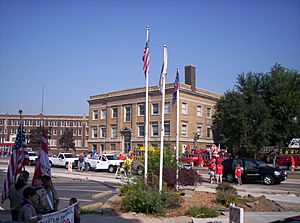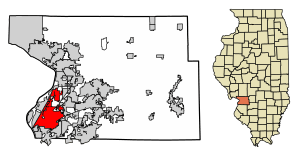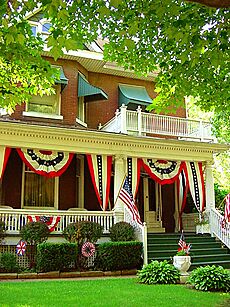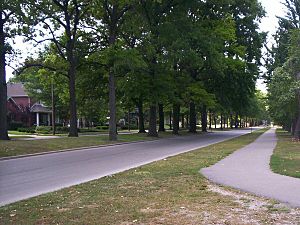Granite City, Illinois facts for kids
Quick facts for kids
Granite City, Illinois
|
|
|---|---|

City Hall of Granite City
|
|

Location of Granite City in Madison County, Illinois
|
|
| Country | United States |
| State | Illinois |
| County | Madison |
| Government | |
| • Type | Mayor-council |
| • Body | City Council |
| Area | |
| • Total | 20.58 sq mi (53.30 km2) |
| • Land | 19.02 sq mi (49.25 km2) |
| • Water | 1.56 sq mi (4.05 km2) |
| Elevation | 423 ft (129 m) |
| Population
(2020)
|
|
| • Total | 27,549 |
| • Density | 1,448.80/sq mi (559.39/km2) |
| Time zone | UTC−6 (CST) |
| • Summer (DST) | UTC−5 (CDT) |
| ZIP Code |
62040
|
| Area code(s) | 618 |
| FIPS code | 17-30926 |
| GNIS feature ID | 2394961 |
Granite City is a city in Madison County, Illinois, United States. It's part of the larger St. Louis area. In 2020, about 27,549 people lived there. This makes it the third-largest city in the Metro East and Southern Illinois regions.
Granite City was officially started in 1896. It was named by two brothers, William and Frederick Niedringhaus. They built the city as a special place for workers who made kitchen items from a material called graniteware.
Contents
History of Granite City
Early Days and Settlements
People lived in this area long before Granite City was officially founded. In the early 1800s, settlers began farming the rich land east of St. Louis. Around 1801, a farming area called Six Mile Settlement was created. It was about six miles from St. Louis.
Later, in 1806, there were plans to build the National Road through the area, but it was never finished. By 1817, the area was known as Six Mile Prairie. This helped tell it apart from Six Mile Township. By 1854, the first railroad was built here. In 1856, the name Six Mile was changed to Kinder.
The Story of Graniteware
Granite City was founded in 1896. It was planned as a "company town," much like Pullman, Illinois. This means it was built by a company for its workers. The German immigrant brothers, Frederick G. Niedringhaus and William Niedringhaus, started it for their graniteware kitchen supplies factory.
Since 1866, the Niedringhaus brothers had a company in St. Louis, Missouri called St. Louis Stamping Company. They made kitchen tools from iron. In the 1870s, William found a way to coat metal tools with enamel. This made them lighter and stopped them from rusting. Most enamelware at the time was just one color.
On June 1, 1878, William got a patent for a new method. He found a way to add patterns to enamelware while the enamel was still wet. He would place a thin piece of paper with a pattern on it. The paper would fall off when it dried, leaving the pattern. The brothers' special pattern made the utensils look like granite. This product became extremely popular.
The brothers opened the Granite Iron Rolling Mills in St. Louis. This plant supplied tin to their growing kitchen supplies business. The tin was imported from Wales.
Frederick Niedringhaus became a member of Congress in 1888. During his time there, he helped pass a new tax on imported iron and tin. This tax made it more expensive to bring these materials into the U.S. Because of this, the American steel industry, including their own iron plant, grew very quickly.
The brothers wanted to make their steel works bigger. However, the city of St. Louis didn't want the expansion. Also, a railroad company planned to tax coal that crossed the Mississippi River into Missouri. These issues led them to look for a new location.
Another big factory in the city was the Commonwealth Steel Company. This company started in 1901 with ideas about helping its workers. It was later bought by the General Steel Castings Corporation in 1929.
Building a Company Town
In 1891, the Niedringhaus brothers bought about 3,500 acres (14 km2) of land. This land stretched from the Mississippi River for their new Granite City.
With help from the St. Louis City Engineer, they designed the city streets. The streets were named in alphabetical order, plus numbered streets. The only exception was Niedringhaus Avenue, named after the brothers.
The Niedringhaus family wanted their employees to live in the new town. Workers could buy houses with mortgages from the Niedringhaus company. But unlike some other company towns, the brothers didn't control the daily lives of their employees. They let the residents govern the city themselves.
At that time, African-Americans were not allowed to live in Granite City. Instead, they lived in nearby Brooklyn, Illinois.
The factory grew to be very large, covering about 1,250,000 square feet (116,000 m2). It employed more than 4,000 people. The factory did well until the 1950s. Then, new materials like aluminum, stainless steel, and pyrex started to replace iron-based kitchen tools.
Even today, the granite pattern on kitchen utensils, especially roasting pans, is still very popular.
Early City Life
In 1896, Granite City officially became a city in Madison County, Illinois. The first seven years saw fast growth. Henry Fossiek became the first policeman. A School Board was chosen by the Mayor, and four schools opened. The first church, Concordian Lutheran Church, was built. The Stamping Company changed its name to National Enameling & Stamping Company (NESCO). Land was sold for a new neighborhood called 'Granite Park,' now known as West Granite.
In 1903, a huge flood covered all of West Granite. However, the rest of the town stayed mostly dry.
From 1906 to 1908, about ten thousand people moved to Granite City. They came from places like Macedonia, Bulgaria, and Hungary. Many of these immigrants, especially from Hungary, settled in an area now called Lincoln Place. Back then, it was known as 'Hungary Hollow.' During a tough economic time in 1907, this area was sadly nicknamed 'Hungry Hollow' because many immigrants faced hunger. The next year, William Niedringhaus, one of the city's founders, passed away. This marked a new time for both the company and the city.
During this period, St. Joseph Catholic Church was started. A system of canals and levees was also built to help with water control. The Methody Bulgarian Church in America was built in Hungary Hollow for the many Bulgarians living there. At one point, Granite City had the largest group of Bulgarians in the U.S. It also had the only American newspaper printed in the Bulgarian language.
After the 1915 Armenian Genocide, many Armenians came to the United States. They found jobs at the steel mills in Granite City. This led to a strong Armenian community in the town, with many settling in Lincoln Place. They have kept their church and a community center, along with a local youth group.
Around 1903, Granite City asked its African American residents to leave. In 1967, a civil rights group said that Granite City had a history of not allowing African Americans to stay after dark. The mayor at the time, Donald Partney, said that people commonly believed this rule existed, but he denied it was an official city law.
Granite City Today
Today, several large manufacturing companies operate in Granite City. These include U.S. Steel, Precoat Metals, Capri-Sun, Kraft Foods, Heidtman Steel, Prairie Farms, and American Steel. The clothing store Glik's also has its main office in Granite City. In July 2018, President Donald Trump visited the city. He gave a speech about the growth of industry at the U.S. Steel plant.
A study in 2024 looked at 17 coke-burning factories in the U.S. It suggested that the SunCoke Energy plant in Granite City might cause health problems for residents. These could include 6-11 early deaths and more asthma symptoms each year.
Geography and Location
Granite City is located at 38°43′4″N 90°7′46″W / 38.71778°N 90.12944°W. It is next to the Chain of Rocks Canal on the Upper Mississippi River. It also borders Horseshoe Lake on its southeast side. The city is in the American Bottom, which is a wide, flat, and fertile plain.
Even though it was at risk during the Great Flood of 1993, the city was protected by levees. These levees are along both the Mississippi River and the Chain of Rocks Canal, so the city never flooded.
Granite City is close to five major interstate highways. Interstate 270 runs through the northern part of the city. Interstates 255, 70, 55, and 64 all pass just south and east of the city.
Route 3 is an important road along the western edge of the city. It provides access to downtown St. Louis across the recently updated McKinley Bridge.
According to the 2010 census, Granite City covers about 20.70 square miles (53.6 km2). Most of this, about 19.29 square miles (49.96 km2), is land. The remaining 1.41 square miles (3.65 km2) is water.
City Layout and Neighborhoods
Granite City has seven main areas: Downtown, East Granite, West Granite, North Granite, Nameoki Strip, Bellemore Area, and the Wilson Park Area. Most stores and restaurants are found on the Nameoki Strip, which is around Nameoki Road.
The Wilson Park area is home to Coolidge Middle School and Granite City High School. It also has the city's main park, Wilson Park. People sometimes call Wilson Park the "heart" of Granite City. It is known for its well-kept homes from the early 1900s.
East Granite is mostly modern homes and includes St. Elizabeth and Holy Family Catholic Schools. It is north of the U.S. Steel plant. This plant was once known as the Granite City Steel Co.
Downtown is in the southwestern part of the city. It has many of the city's industries, including the Granite City Steel Works. Downtown Granite faced challenges in the 1970s, which led to many empty buildings. More recently, there have been efforts to bring the downtown area back to life. These efforts include adding tree-lined areas on Niedringhaus Avenue, opening new businesses like the Granite City Theater, and fixing up streets. The original design of downtown Granite City was based on Washington D.C.
West Granite is located west of downtown, across the railroad tracks. This area has both industrial sites and homes. West Granite has been working to improve its crime rate. While Wilson Park is the "heart," West Granite holds much of the city's history. Many immigrants from Central and Eastern Europe, especially Bulgaria, Ottoman Macedonia, and Hungary, came here for jobs. Most of them settled in West Granite in a place called 'Hungary Hollow.' By 1916, this area was officially renamed Lincoln Place.
Population and People
| Historical population | |||
|---|---|---|---|
| Census | Pop. | %± | |
| 1900 | 3,122 | — | |
| 1910 | 9,903 | 217.2% | |
| 1920 | 14,757 | 49.0% | |
| 1930 | 25,130 | 70.3% | |
| 1940 | 22,974 | −8.6% | |
| 1950 | 29,465 | 28.3% | |
| 1960 | 40,073 | 36.0% | |
| 1970 | 40,685 | 1.5% | |
| 1980 | 36,815 | −9.5% | |
| 1990 | 32,862 | −10.7% | |
| 2000 | 31,301 | −4.8% | |
| 2010 | 29,849 | −4.6% | |
| 2020 | 27,549 | −7.7% | |
| U.S. Decennial Census 2018 Estimate |
|||
In 2010, there were 29,849 people living in Granite City. There were 12,214 households and 7,791 families. The city had about 1,547.5 people per square mile (597.5/km2).
The people living in Granite City were mostly White (91.5%). There were also Black or African American (6.5%), Native American (1.0%), and Asian (0.8%) residents. About 5.0% of the population was Hispanic or Latino.
In terms of age, 22.9% of the population was under 18 years old. About 15% were 65 years or older. The average age in the city was 38.2 years.
In 2014, the average income for a household in the city was $43,759. For families, the average income was $57,596. About 18.3% of the people in Granite City lived below the poverty line. This included 27.7% of those under 18 and 7.2% of those 65 or older.
Fun and Recreation
The Granite City Park District manages 13 parks. Wilson Park is the most well-known. A 1.4-mile (2.3 km) paved path goes around the 74-acre (30 ha) park. The park has a swimming pool, an ice rink, a skate park, tennis courts, and baseball fields. It also has places for food and drinks, several picnic areas, and a wedding spot. The Park District offers sports programs for kids, including baseball, flag football, tennis, soccer, basketball, and hockey.
Every summer around July 4th, Wilson Park hosts the Patriots in the Park event. This event features live music, carnival rides, food, and one of the biggest fireworks shows in the St. Louis area.
Madison County Transit has a great 85-mile (137 km) network of paved bike paths throughout the county, including in Granite City.
A new YMCA has also been built. It offers swimming programs, a youth center, weightlifting, batting cages, basketball and tennis courts, and child care.
There are two golf courses near Granite City: The Legacy Golf Course and the Arlington Golf Course. Both have 18-hole championship courses. Horseshoe Lake State Park surrounds Horseshoe Lake, which is a 2,400-acre (970 ha) natural lake. It's the largest lake in the St. Louis area. The park is a great place for picnics, biking, fishing, watching wildlife, and small boating. Hunting is allowed during hunting season, and there's a small camping area on Walker's Island.
There are also two roller skating rinks nearby. The Confluence Crush Roller Derby team practices in the nearby village of Pontoon Beach.
Transportation
Railroad Service
The Port Harbor Railroad (PHRR) provides train service to businesses at America's Central Port in Granite City. The PHRR connects with the Terminal Railroad Association of St. Louis at "WR Tower." This is a major railroad crossing at Niedringhaus Avenue and 16th Street. The railway transports many different goods, such as steel, aluminum, food, lumber, paper, chemicals, minerals, and grains.
Education in Granite City
Granite City Community Unit School District 9 serves about 7,100 students from the city and nearby areas. The district has five elementary schools (Frohardt, Mitchell, Wilson, Prather, and Maryville), one intermediate school (Grigsby), one junior high (Coolidge), and one high school (Granite City High School (GCHS)). The high school recently had a $14 million renovation.
The district is known for its many sports, clubs, and technical programs. The track, baseball field, and high school gym have also been updated. The high school has a 96.3% graduation rate, which is almost 10% higher than the state average. Granite City High School won the state basketball championship in 1940. Their boys' soccer team has won ten state championships (in 1972, 1976–1980, 1982, 1987, 1989, and 1990). The girls' soccer team won the state championship in 2011. Also, the Warrior wrestling team shared the state championship in 1965 and has won more dual meets than any other high school in the country. The baseball team was runner-up in 1963.
There are also two private Catholic schools for grades K-8 in the city: Holy Family and St. Elizabeth.
Alternative schools include the Coordinated Youth on Madison Avenue and another location on W 3rd St.
The Sam Wolf Granite City Campus (SWGCC) of Southwestern Illinois College is located at the northern end of the city.
Notable People from Granite City
Many interesting people have come from Granite City, including:
- George Becker, a labor leader who was president of the United Steelworkers.
- Robert Olen Butler, a writer who won a Pulitzer Prize.
- L. J. Fort, a linebacker for the NFL's Pittsburgh Steelers and Baltimore Ravens.
- Kevin Greene, a former National Football League linebacker.
- Matt Hughes, a former UFC welterweight champion.
- Robbie Lawler, a former Elite XC middleweight champion.
- Dal Maxvill, a former MLB shortstop and general manager for the St. Louis Cardinals.
- Andy Phillip, a basketball Hall of Famer.
- Murphy Lee, a rapper.
- Jason Robertson, an AIDS activist.
- Ralph T. Smith, a former Senator.
- Stephen Trittschuh, a Major League Soccer defender and member of the US Men's National Soccer Team.
- Anna M. Valencia, the Chicago City Clerk.
- Whip Wilson, an actor in Western films.
See also
 In Spanish: Granite City para niños
In Spanish: Granite City para niños




